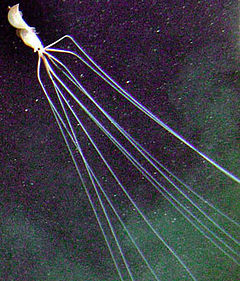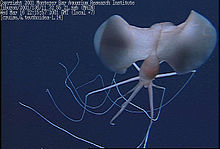- Bigfin squid
-
Bigfin squids 
The long-arm squid filmed by DSV Alvin,
possibly an adult Magnapinna sp.Scientific classification Kingdom: Animalia Phylum: Mollusca Class: Cephalopoda Order: Teuthida Suborder: Oegopsina Family: Magnapinnidae
Vecchione & Young, 1998Genus: Magnapinna
Vecchione & Young, 1998Species Magnapinna atlantica
Magnapinna pacifica (type)
Magnapinna talismani
Magnapinna sp. B
Magnapinna sp. CThe bigfin squids are a group of rarely seen cephalopods with a distinctive morphology. They are placed in the genus Magnapinna and family Magnapinnidae. The family is known only from larval, paralarval, and juvenile specimens, but some authorities believe the adult creature has been seen: several videos have been taken of animals nicknamed the "long-arm squid", which appear to have a similar morphology. Since none of the adult specimens have ever been captured or sampled, it remains uncertain if they are the same genus, or only distant relatives.
Contents
Physical specimens
The first record of this family comes from a specimen (Magnapinna talismani) caught off the Azores in 1907.[1] However, due to the damaged nature of the find, very little information could be discerned and it was lumped in with the mastigoteuthids, first as Chiroteuthopsis talismani[1] and later as Mastigoteuthis talismani. In 1956 a similar squid (Magnapinna sp. C) was caught in the South Atlantic, but little was thought of it at the time. The specimen was illustrated in Alister Hardy's The Open Sea (1956), where it was identified as Octopodoteuthopsis.[2]
During the 1990s two more immature specimens were found in the Atlantic (Magnapinna sp. A), and three more were found in the Pacific (Magnapinna pacifica). Researchers Michael Vecchione and Richard Young were the chief investigators of the finds, and eventually linked them up to the two previous specimens, erecting the family Magnapinnidae in 1998, with Magnapinna pacifica as the type species.[3] Of particular interest was the very large fin size, up to 90% of the mantle length, that was responsible for the animals' nickname.
A single specimen of a fifth species, Magnapinna sp. B, was collected in 2004. Magnapinna sp. A was described as Magnapinna atlantica in 2006.[4]
Sightings
The first visual record of the long-arm squid dates back to September 1988. The crew of the submersible Nautile encountered a long-armed squid off the coast of northern Brazil, 10°42.91′N 40°53.43′W / 10.71517°N 40.8905°W, at a depth of 4,735 metres (15,535 ft). In July 1992, the Nautile again came across these creatures, first observing one individual two times during a dive off the coast of Ghana at 3°40′N 2°30′W / 3.667°N 2.5°W and 3,010 metres (9,880 ft) depth, and then another one off Senegal at 2,950 metres (9,680 ft)[verification needed]. Both were filmed and photographed.[5]
In November 1998, the Japanese manned submersible Shinkai 6500 filmed another long-armed squid in the Indian Ocean south of Mauritius, at 32°45′S 57°13′E / 32.75°S 57.217°E and 2,340 metres (7,680 ft). A third video taken from the ROV of the oil-drilling ship Millennium Explorer in January 2000, at Mississippi Canyon in the Gulf of Mexico (28°37′N 88°00′W / 28.617°N 88°W) at 2,195 metres (7,201 ft) allowed a size estimate. By comparison with the visible parts of the ROV, the squid was estimated to measure 7 meters with arms fully extended.[5]
The ROV Atalante filmed another Indian Ocean specimen at 19°32′S 65°52′E / 19.533°S 65.867°E and 2,576 metres (8,451 ft), in the area of Rodrigues Island, in May 2000.[5] The year 2000 was a boon year for observations of these enigmatic animals, for in October, the manned submersible Alvin found yet another long-armed squid at 1,940 metres (6,360 ft) in Atwater Valley, Gulf of Mexico (27°34.714′N 88°30.59′W / 27.578567°N 88.50983°W).
These videos did not receive any media attention; in any case, most were brief and fairly blurry. However, in May 2001, some ten minutes of crisp footage of a long-armed squid were acquired by ROV Tiburon, causing a flurry of attention when they were released.[6] These were taken in the Pacific Ocean north of Oʻahu, Hawaiʻi (21°54′N 158°12′W / 21.9°N 158.2°W), at 3,380 metres (11,090 ft).
On November 11, 2007, a new video of a long-arm squid was filmed off Perdido, a drilling site owned by Shell Oil Company, located 200 statute miles (320 km) off Houston, Texas in the Gulf of Mexico.[7]
The specimens in the videos looked very distinct from all previously known squids. Uniquely among cephalopods, the arms and tentacles were of the same length and looked identical (like extinct belemnites). The appendages were also held perpendicular to the body, creating the appearance of strange "elbows". Most remarkable was the length of the elastic tentacles, which has been estimated at stretching up to 15–20 times the mantle length. Estimates based on video evidence put the total length of the largest specimens at 8 m or more.[8] On close ups of the body and head, it is also apparent that the fins are extremely large, being proportionately nearly as big as those of bigfin squid larvae. While they do appear similar to the larvae, no specimens or samples of the adults have been taken, leaving their exact identity unknown.
Feeding behavior
Very little is known about the feeding behavior of these squid. Scientists have speculated that bigfin squid feed by dragging their arms and tentacles along the seafloor, and grabbing edible organisms off the floor.[7] Alternatively, they may simply use a trapping technique, waiting passively for prey to bump into their arms.[7] (See Cephalopod intelligence.)
See also
References
- ^ a b Fischer, H. & L. Joubin (1907): Expéditions scientifiques du Travailleur et du Talisman. Céphalopodes 8: 313–353.
- ^ Hardy, A.C. (1956): The Open Sea: Its Natural History. Collins, London.
- ^ Vecchione, M. & R.E. Young. (1998): The Magnapinnidae, a newly discovered family of oceanic squids (Cephalopoda; Oegopsida). South African Journal of Marine Science 20: 429–437.
- ^ Vecchione, M. & R.E. Young. (2006): The squid family Magnapinnidae (Mollusca; Cephalopoda) in the North Atlantic with a description of Magnapinna atlantica, n. sp.. Proceedings of the Biological Society of Washington 119(3): 365–372.
- ^ a b c Guerra, A.; González, A.F.; Rocha, F.; Segonzac, M. & Gracia, J. (2002): Observations from submersibles of rare long-arm bathypelagic squids. Sarsia 87(2): 189–192. doi:10.1080/003648202320205274 (HTML abstract)
- ^ 'Mystery' squid delights scientists. BBC News, December 21, 2001.
- ^ a b c Hearn, K. (2008): Alien-like Squid With "Elbows" Filmed at Drilling Site. National Geographic News, November 24, 2008.
- ^ Bolstad, K. (2003): Deep-Sea Cephalopods: An Introduction and Overview. The Octopus News Magazine Online.
- Vecchione, M.; Young, R.E.; Guerra, A.; Lindsay, D.J.; Clague, D.A.; Bernhard, J.M.; Sager, W.W.; Gonzalez, A.F.; Rocha, F.J. & Segonzac, M. (2001): Worldwide observations of remarkable deep-sea squids. Science 294(5551): 2505-2506. doi:10.1126/science.294.5551.2505 (HTML abstract)
- Shuker, Karl P.N. (2002). The New Zoo: New and Rediscovered Animals of the Twentieth Century. House of Stratus (Thirsk).
External links
- Tree of Life Web Project: Magnapinna
- Cephalopods in Action: Long-armed squid videos
Wikimedia Foundation. 2010.

